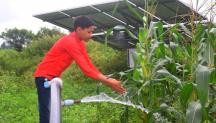

-
-
IEA, IRENA, UNSD, World Bank, WHO. 2024. Tracking SDG 7: The Energy Progress Report. World Bank, Washington DC. © World Bank. License
Copied
https://www.irena.org/-/media/Files/IRENA/Agency/Publication/2024/Jun/IRENA_Tracking_SDG7_energy_progress_2024.pdf
Copied
Tracking SDG 7: The Energy Progress Report 2024
Newsletter
Jointly produced by IRENA in collaboration with the International Energy Agency (IEA), the United Nations Statistics Division (UNSD), the World Bank and the World Health Organization (WHO), and led by the IEA in 2024, this annual publication monitors global progress towards meeting Sustainable Development Goal (SDG) 7, which aims to ensure affordable, reliable, sustainable and modern energy for all.
Despite improvements across indicators – such as energy access, energy efficiency, renewable energy adoption and international cooperation – the current pace of progress falls short of that required to achieve the SDG7 targets by 2030.
The report finds that 91 percent of the global population had access to electricity in 2022, leaving 685 million people still without access – 10 million people more than in 2021. Similarly, while 74 percent of the world’s population had access to clean cooking technologies in 2022, 2.1 billion people still relied on polluting fuels, with only modest progress expected by 2030. Renewables accounted for 18.7% of total final energy consumption worldwide in 2021, barely higher than the 16.7 percent in 2015; and the world is not on course to double energy efficiency by 2030, having improved by only 0.8 percent in 2021.
Whilst international public financial flows in support of clean energy in developing countries rebounded in 2022 to USD 15.4 billion – an increase of 25% compared to 2021 – they remain concentrated in certain geographies, with 80% of flows directed to just 25 countries.
The SDG 7 custodian agencies emphasise the need for intensified efforts to expand energy access, scale up renewable energy deployment, enhance energy efficiency and substantially increase international financial flows to developing countries for clean energy projects. These efforts are crucial not only for realising SDG 7 but also for achieving the global objectives of tripling renewable energy capacity and doubling energy efficiency by 2030, as well as limiting global temperature rise to 1.5 degrees Celsius above pre-industrial levels by the end of the century.
Dashboards and additional information are available on the Tracking SDG 7 website.




